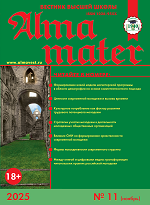UDC (316.4/.6+378)::343.9
https://doi.org/10.20339/AM.12-19.099
F. Fosso,
PhD student,
Ural Federal University
e-mail: fabricefosso@outlook.com
Analyzed is the problem of relationship between perceptions of crime and enrollment of foreign students at Russian universities. A lot of studies have been done on foreign students, but very few on their perception of crime and its effects in their enrollment at campuses. On the one hand, Russia is often portrayed as a dangerous place for Asians, Africans, and non-Slavic residents from the former-Soviet Central Asia, especially if one looks at the crime statistics against foreigners living in Russia for the past decades, and on the other, as a country whose educational system has run askew. In such a context, this paper discusses such effects in order to attribute not exclusively the fault to either crime or inadequate education.
Key words: perceptions of crime, foreign students, Russia, Higher education, Enrollment.
References
1. Arrigo, B. & Williams, C., 2006. Philosophy, Crime, and Criminology. Arrigo, B. & Williams, C. ed. Chicago: University of Illinois Press.
2. Baier, D., Hanslmaier , M. & Kemme, S., 2016. Public Perceptions of Crime. In: C.P. Dirk Baier, ed. Representative Studies on Victimisation:Research Findings from Germany. Baden-Baden: Nomos Verlagsgesellschaft mbH & Co. P. 39–63.
3. DiCristina, B., 2016. Criminology and the “Essence” of Crime: The Views of Garofalo, Durkheim, and Bonger. International Criminal Justice Review, 26(4). P. 297–315.
4. Friedrichs, O.D., 2013. Transcending the conventional definition of crime: Toward a twenty-first century criminology. Atlanta: Paper presented at the annual meeting of the American Society of Criminology.
5. Hessler, J., 2006. Death of an African Student in Moscow. Paris, France: Cahiers du monde russe.
6. Jackson, J. et al., 2012. Why do People Comply with the Law?: Legitimacy and the Influence of Legal Institutions. British Journal of Criminology, 52 (6). P. 1051–1071.
7. Moscovici, S., 1976. La psychanalyse, son image et son public. Paris: PUF.
8. Muncie , J. (ed.), 2005. Criminology: The meaning of crime: Definition, representation and social construction. Volume 1. London: Sage Publications Ltd.
9. Pardal, L., Albuquerque, D., Lopes, M. & Ferrӓo, M.E., 2013. Statistical Evidence on Social Representations of Teachers in Argentina, Brazil and Portugal. Procedia — Social and Behavioral Sciences, 82(2013). P. 734–739.
10. Tyler, R.T., 2006. Why People Obey the Law. Princeton: Princeton University Press.
11. Windzio, M., Simonson, J., Pfeiffer, C. & Kleimann, M., 2007. Kriminalitätswahrnehmung und Punitivität in der Bevölkerung – Welche Rolle spielen die Massenmedien? Ergebnisse der Befragungen zu Kriminalitätswahrnehmung und Strafeinstellungen 2004 und 2006. Hannover: KFN.











.png)






